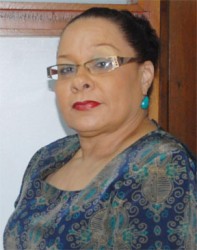Public Relations Officer of the recently established Guyana Fashion Council (GFC) Andrea Braithwaite is optimistic about what the new organisation can do for the sector in Guyana.
She says the council goes beyond the decorative appeal that can sometimes attend what is often the vanity-driven world of fashion. It seeks to embrace the fashion industry in its broadest sense, from high-flying clothing designers to modest investors in decorative jewellery. That way, she says, everyone’s interests get taken on board.

The council was established in May this year. Braithwaite says this was not the first attempt to bring the industry together. This time around the difference reposes in the broadness of the agenda. She credits the Guyana Manufacturing & Services Association (GMSA) and the Caribbean Export Development Agency (Caribbean Export) with getting the initiative off the ground. Caribbean Export, through funding from the European Union (EU) allocated €32,000 to the startup of the initiative.
The focus, Braithwaite says, will be on “raising standards” in the industry. What that means is that much of the effort of the council will be concentrated on training. Braithwaite says that after 20 years in the sector she is aware of where at least some of the problems lie. “There are problems of standards, of understanding what those standards are and what the market accepts. A lot of the work that the council will have to do has to do with educating people who are already in the industry.”
There is, she says, little doubt about the availability of talent. “There is evidence of it in the work that you see. Talent, however, needs to be refined and that is part of the focus of the council,” she says.
What is potentially a multi-million dollar industry is hamstrung by limitations that include financing and the absence of a sense of family. Braithwaite is not critical of the tendency towards individualism in creative people, though she says there are distinct commercial advantages to be secured from working together. “We need to be clear about what the fashion industry is. Fashion designers may be in the limelight but the industry is also about those highly talented seamstresses and the creators of handbags and jewellery and shoes. It is possible that a designer of handbags can work with a clothing designer to have an entire line of clothing developed around his or her handbags. That way, different sections of the industry benefit from working together,” she says.
There are other ways, too, in which collaboration can help the industry. Braithwaite says the connections that derive from bilateral relations at the country-to-country level can benefit the fashion industry in several ways. “One of the ways I can think about has to do with the kind of official help we might get in securing access to the fabric industries in countries like India and China. I am sure, for example, that a lot of good can come from GFC representation on an official Guyana delegation to China or India specifically to investigate ways in which we might be able to access the fabric industry in those countries.”
Braithwaite is brutally frank on markets. She says that except for limited niche opportunities, the ferocious competition in the United States makes entry into that market “extremely difficult”. On the other hand, she says, local designers have already made some measure of impact in the Caribbean. “There are definitely opportunities in the region and some of the local designers have been taking advantage of them.”
Braithwaite believes that the creation of the GFC has provided an incentive for the sector but that it still has its work “cut out”. She talks about other challenges associated with the growth of the industry. “We need more acceptance at home. The reality is that it is still more cost-effective to buy imported creations. The importers are still able to travel abroad and make cheaper purchases.”
She is surprisingly philosophical about what is loosely described these days as the commercial invasion by the Chinese. She concedes that cost is a consideration but also believes that “it is a matter of finding support for our designs among our own people.”
National appreciation, Braithwaite says, includes public and private sector backing for the industry. Fit Me 2013, the GFC’s inaugural fashion display was intended to mark the start of an accelerated venture to aggressively promote the sector. “GuyExpo is what we have at the moment but we really do need a forum that belongs exclusively to the fashion industry, where we can attract our own crowd, fashion our markets and give designers of clothing, jewellery, bags and the various other things associated with fashion an opportunity to shine,” she says.
Braithwaite is unsure of the size of the industry. “The problem is that there is a lot of hidden talent. Though if you assess it from a household perspective I am pretty sure that fashion can contribute significantly to employment. That, in my view, is one of the challenges confronting the council. We have a lot of work to do.”




